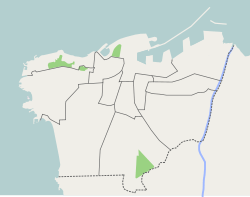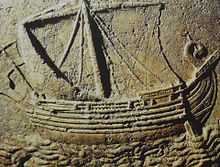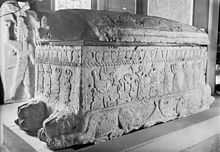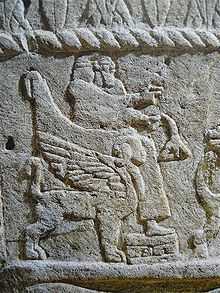National Museum of Beirut
| National Museum of Beirut | |
|---|---|
|
Logo of the National Museum of Beirut | |
 Location within Beirut | |
| Established | 1937 |
| Location | Beirut, Lebanon |
| Coordinates | 33°52′42″N 35°30′54″E / 33.878384°N 35.514959°E |
| Type | Archaeological |
| Visitors | 40,211 (2009)[1] |
| Director | Anne-Marie Ofeish[2] |
| Website | http://www.beirutnationalmuseum.com/ |
The National Museum of Beirut (Arabic: متحف بيروت الوطنيّ) is the principal museum of archaeology in Lebanon. The collection was begun after World War I, and the museum was officially opened in 1942. The museum has collections totalling about 100,000 objects, most of which are antiquities and medieval finds from excavations undertaken by the Directorate General of Antiquities. About 1300 artifacts are exhibited, ranging in date from prehistoric times to the medieval Mamluk period.
During the 1975 Lebanese Civil War, the museum stood on the front line that separated the warring factions. The museum's Egyptian Revival building and its collection suffered extensive damage in the war, but most of the artifacts were saved by last-minute pre-emptive measures.
Today, after a major renovation, the National Museum of Beirut has regained its former position, especially as a leading collector for ancient Phoenician objects.
History
Origin

In 1919, a small group of ancient artifacts collected by Raymond Weill, a French officer stationed in Lebanon, was exhibited at a provisional museum in the Kaiserswerth Deaconesses' building in Georges Picot Street, Beirut.[3][4] Meanwhile, a forerunner of the Archaeological and Fine Arts Service began to assemble items from the region round Beirut. The initial collection was rapidly expanded under successive antiquity directors with the addition of finds from the excavations led by Dr. Georges Contenau at Saida and Ernest Renan at Saida, Tyre[5] and Byblos.[6] Donations of private collections[5] included those of Henry Seyrig’s coin collection,[7] General Weygand in 1925[5] and Dr George Ford, the Director of the American Mission School of Sidon, in 1930.[5]
Foundation

In 1923, the "Friends of the Museum Committee",[8] headed by Bechara El Khoury, then Prime Minister and minister of education and fine arts, was created to raise funds to build a national museum.[3][4] The founding committee included: Alfred Sursok, Marios Hanimoglo, Albert Bassoul, Omar Daouk, Kamil Eddeh, Ali Jumblat, Henry Pharaoun, George Faissy, Assad Younes, Hassan Makhzoumi, Joseph Farahi, George Korom, Jean Debs, Wafik Beydoun and Jack Tabet. The committee accepted the plans presented by architects Antoine Nahas and Pierre Leprince-Ringuet. Construction began in 1930 on a plot of land donated by the municipality near the Beirut Hippodrome, and was completed in 1937.[3][4] The opening of the museum was scheduled for 1938, but was postponed because of the political situation in the lead-up to World War II.[8] The National Museum of Beirut was finally opened on May 27, 1942 by President Alfred Naqqache.[3][4] Until 1928, the conservation of the Lebanese National Museum was put in the hands of Charles Virolleaud, the director of the service of antiquities and Philippe de Tarazzi, the Lebanese conservator of the National Library. The collection continued to grow under the direction of Mir Maurice Chehab, head curator for 33 years,[8][9] until the start of the Lebanese Civil War in 1975.[4]
Closing and devastation


In 1975, with the outbreak of the Lebanese war, Beirut was split into two opposing areas. The national museum and the directorate general of antiquities were on the demarcation line known as “Museum alley” which separated the warring militias and armies.[4][10] Conditions in the immediate vicinity of the museum rapidly worsened,[10] as the museum endured shelling and bombing, and was turned into a barracks for combatants.[4][11] "Museum alley" became a checkpoint controlled by various Lebanese militias, or the Syrian or Israeli armies, who opened and closed the road under short-lived truces.[11][12] The authorities decided to close the museum. The first protective measures inside the museum were initiated by Mir Maurice Chehab and his wife[13][14] during alternating fire-fights and moments of truce. The vulnerable small artifacts were removed from their showcases and hidden in storerooms in the basement, which was then walled up, banning any access to the lower floors. On the ground floor, mosaics which had been installed in the floor were covered with a layer of concrete. Statues and sarcophagi were protected by sandbags. When the situation reached its worst in 1982, the heavier artifacts were encased in wood and concrete.[4][15]
When the final cease-fire was declared in 1991, the museum and the Directorate General of Antiquities were in a state of near-destruction. The museum was flooded with rainwater and the outer facade was badly marked by bullets and craters from shells. Militiamen who occupied the premises had covered the internal walls with graffiti. The state of the museum collection was also very serious: the small objects had been left in the storerooms for more than fifteen years in a totally inappropriate environment. The national museum had been built on a high water table, which caused a dangerous increase in humidity, and collection of water inside the storerooms. The large stone artifacts has been left in their emergency casings without any ventilation and traces of corrosion from salts were visible on the lower edges of the stone monuments. The wing adjacent to the Directorate General of Antiquities was devastated by shells which started a fire, destroying documents such as maps, photographs, and records, as well as 45 boxes containing archaeological objects. All of the laboratory equipment was lost.[3][4] During the war, some items were looted and are now exhibited in Turkish museums, whilst others have been auctioned. Ironically, these had been stolen from external stores, mainly in Byblos and Sidon, in which they were kept to avoid damage and looting.[16][17]
Reopening and renovation

The first plans to restore the national museum came in 1992 from Michel Edde, then Minister of Culture and Higher Education. The proposal to tear down the concrete walls and cases which protected the national treasures was turned down by the general director of antiquities, Camille Asmar, since the museum still had no doors or windows to prevent further looting. Ghassan Tueni donated the funds for the museum's massive new main door. Once the doors and windows were put in, the decision was made to pull down the concrete wall that protected the entrance to the basement.[14] Restoration work started in 1995 and focused on the building itself, and the inventorying and restoration of the collection.[4] The museum was officially inaugurated on November 25, 1997 by then president Elias Hrawi but only parts of the ground floor and basement were made accessible since the remainder of the building was still under repair and important modifications were needed to meet the requirements of modern museology standards. The museum was again closed to the public in July 1998 to achieve restoration works.[3] On October 8, 1999, the museum re-opened its doors to the public under the patronage of president Emile Lahoud.[3][4]
The rehabilitation of the National Museum was undertaken by the Ministry of Culture, the Directorate General of Antiquities and the National Heritage Foundation,[4][18] to the plans of the French architect, urban planner and designer Jean-Michel Wilmotte.[19] In 1999 the Lebanese government started a massive campaign to recover antiquities that were stolen or traded during the civil war.[20] Many artifacts were recovered from warehouses or private homes since Lebanese law dictates that any item more than 300 years old belongs to the state.[21]
Basement reopening
Opening of the basement floor was scheduled for November 2010,[22] but as of June 2011, only the ground and first floors are open to the public.[23]
Architecture

The museum was designed in a French inspired[24] Egyptian Revival style by the architects Antoine Nahas and Pierre Leprince Ringuet, and built with Lebanese ochre limestone. It comprises a basement, a ground floor, a mezzanine floor and a terrace; the central block is covered by a glass roof, above the mezzanine, giving natural overhead light.
The whole site is approximately 5,500 square metres (59,000 sq ft), and the exhibition floor space totals 6,000 square metres (65,000 sq ft). The immediately adjoining museum annexes and administrative offices occupy about 1,000 square metres (11,000 sq ft).[5]
Collections
The National Museum of Beirut currently exhibits 1300 artifacts from its collection of approximately 100,000 objects.[25] The museum displays follow a chronological circuit beginning in Prehistory and ending in the Ottoman era. The circuit begins on the ground floor where 83 large objects are displayed, these include sarcophagi, mosaics statues and reliefs. The upper floor displays 1243 small and medium-sized artifacts arranged by chronological order and by theme in modern showcases with soft lighting and magnifying glasses that emphasize the aesthetic aspect of the artifacts.[3]
Prehistory
The collection has prehistoric artifacts from early hunter-gatherer societies[7] ranging from the Lower Paleolithic (1M.-150.000 BC) to the Neolithic (9000–3200 BC), typically spearheads, flints, hooks and pottery.[26] These were found in caves and rock shelters all over Lebanese territory.[26] Around five hundred prehistoric sites have been surveyed in Lebanon as a whole, and around fifty sites in Beirut itself.[7]
Bronze age
The Bronze Age (3200–1200 BC) saw the birth of Lebanon's first fortified villages, the development of commercial and maritime activities and the invention of the world's first alphabet in Byblos.[26] This collection includes the Museum's masterpiece: the sarcophagus of Ahiram, which holds the oldest text written in the Phoenician alphabet.[27]
Collection highlights:
- Sarcophagus of King Ahiram: limestone, Byblos royal cemetery, 10th century B.C.[10]
- Votive statuettes: gilded bronze, Obelisk temple – Byblos, 19-18th century B.C.
- Decorated knife:gold and ivory, Obelisk temple – Byblos, 19-18th century B.C.
- Fenestrated axes: gold, Obelisk temple – Byblos, 19-18th century B.C.
- King Ip Shemu Abi's crown and scepter: gold and bronze, Royal cemetery, Byblos, 18th century B.C.
- King Abi Shemu's jewelry collection: gold and precious stones, Royal cemetery, Byblos, 18th century B.C.
- Statuette of Reshep: gilded bronze, Obelisk temple – Byblos, 19-18th century B.C.
- Duck shaped cosmetic box: ivory, Sidon, 14th century B.C.[26][28]
Iron age

The Iron Age (1200 – 333 BC) in Lebanon saw the climax of the Phoenician civilization, which culminated in its maritime expansion and the transmission to other cultures of the alphabet (which was attributed by the Greek legend to the Tyrian Cadmus). During this period, after an era of autonomy, the city-states of the area came under Assyrian, Babylonian and Persian hegemony. The occupying civilizations influenced Phoenician ceramics, jewelry and ivory work, statues, and sarcophagi.[26]
Key highlights of the collections include:
- the Ford collection of anthropoid sarcophagi: marble, 4th century B.C.
- votive statues from the Eshmun temple: marble, Bustan esh Sheikh, 4th century B.C.
- capital with bull protomes,: marble, Sidon, 5th century B.C.
Hellenistic period
The Hellenistic period (333 – 64 BC) In 333 BC, the decisive victory won by Alexander the Great over the Persian king Darius III opened Phoenicia to the Greek conqueror.
After Alexander's death, Phoenicia first came under Ptolemaic rule from Egypt, then, after the Battle of Panium, under the Seleucids based in modern Iraq. The Seleucids abolished local monarchies, and appointed governors (bearing Greek names) to rule the Phoenician cities.
Greek influence, which had made its way to Phoenicia during the Persian period, now became stronger. Figurines found in Kharayeb show Aegean influence on local craftsmen. This spreading Hellenization interacted with the local Semitic population substratum, which remained faithful to its gods and its language. It resulted in an artistic and architectural symbiosis best illustrated in the artifacts of Umm el 'Amed and Bustan esh Sheikh.
Collection highlights:
- Sanctuary of Eshmun tribune: marble, Bustan esh Sheikh (near Sidon), ca. 350 B.C.
- Statue of Aphrodite: marble, Beirut
- Greek gods figurines: terracotta, Kharayeb[26]
Roman period

In 64 BC, the military expedition of the Roman general Pompey put an end to the anarchy prevailing in the Seleucid Empire, and Phoenicia became part of the Roman world. But Roman civil wars continued to disrupt the region until 31 BC, after which, with the reign of Augustus, the pax romana extended over the area. The pax romana favored international trade, and local industries in silversmithing, glass, textiles and ceramics developed.
Roman Period (64 BC – 395 AD) section collection highlights include:
- Achilles sarcophagus: marble, Tyre, 2nd century A.D.
- drunken Cupids sarcophagus: marble, Tyre, 2nd century A.D.
- Abduction of Europe mosaic: Byblos, 3rd century A.D.
- statue of Hygieia: marble, Byblos
- Calliope and the seven wise men mosaic: Baalbeck, 3rd century A.D.
- Dionysus bust: marble, Tyre, 3rd century A.D.
Byzantine period
After the death of Theodosius I in 395 AD, the Roman Empire was divided into a western and an eastern empire. The Lebanese cities were attached to the latter, and converted to Christianity which became the state religion in 392. The emperor ordered the destruction of pagan temples, but cults like those of Adonis and Jupiter Heliopolitanus were kept alive by the local population and survived in some form for centuries.
Artifacts from the Byzantine period (395 – 636 AD) include:
- the "Jealousy" mosaic: Beirut
- elements of a church chancel: marble, Beirut
- coins and jewelry collection
Arab conquest, Mamluk period
The Arab conquest of Lebanon was completed in 637 AD. The expansion of the coastal cities, which had slowed down after earthquakes in the 6th century, revived during the Umayyad period. Their harbors and shipyards showed renewed activity, and the hinterland saw extensive irrigation work for agriculture.
Lebanon was directly affected by the various dynastic changes which brought to power successively the Umayyads, Abbasids, Fatimids, Seljuks, Ayyubids and Mamluks. During this long period, Islam spread and Arabic became the language of the administration, then progressively replaced local dialects among the population. Artifacts from the Mamluk period (636 – 1516 AD) include coins, gold jewelry, and glazed terracotta bowls.[26]
Publications
Maurice Chehab initiated in 1936 the museum's first publication, the Bulletin du Musée de Beyrouth ("Beirut Museum Bulletin"), which reached 36 volumes before publication was stopped in 1986 by the civil war.[7] The journal covered archaeological finds, sites and ancient civilizations.[29] In 1995 the Museum and the Lebanese British Friends of the National Museum foundation resumed publication of a bi-annual journal entitled Archaeology and History in Lebanon (ISSN 1475-5564).[30] BAAL ("Bulletin d’Archéologie et d’Architecture Libanaise" – Lebanese Archaeology and Architecture Bulletin) is an annual journal issued by the Directorate General of Antiquities in cooperation with the Lebanese Ministry of Culture in keeping in the tradition of the Beirut Museum Bulletin. The first volume of BAAL was issued in 1996; the journal publishes research papers, excavations and archaeological surveys and reports.[31]
Gallery
-

Some of the artifacts in the museum
-

Ancient tombs displayed in the museum
-

Side of the museum
References
- ↑ "Central Administration for Statistics". 2006 Statistical monthly bulletin. Retrieved June 22, 2010.
- ↑ Farshakh Bejjani, Uan (June 23, 2010). "المتـــاحف للجميـــع!". al-Akhbar (Beirut). Retrieved June 23, 2010.
- ↑ 3.0 3.1 3.2 3.3 3.4 3.5 3.6 3.7 Charles Kettaneh Foundation; Omar Daouk Foundation (2008). A visit to the Museum... The short guide of the National Museum of Beirut, Lebanon. Anis commercial printing press. p. 96. ISBN 9953-0-0038-7.
- ↑ 4.0 4.1 4.2 4.3 4.4 4.5 4.6 4.7 4.8 4.9 4.10 4.11 "Bienvenue au Musée National de Beyrouth". The Beirut National Museum Official Site. Retrieved April 16, 2008.
- ↑ 5.0 5.1 5.2 5.3 5.4 Brigitte Colin. "The Beirut Museum Opens its Doors" (.PDF). UNESCO. Retrieved April 16, 2008.
- ↑ Lee, David C.J. (1996). Ernest Renan: In the Shadow of Faith. London, UK: Duckworth. ISBN 0-7156-2720-1.
- ↑ 7.0 7.1 7.2 7.3 Helga Seeden. "Lebanon's Archaeological Heritage". Lebanese Center for Policy Studies. Archived from the original on March 16, 2008. Retrieved April 18, 2008.
- ↑ 8.0 8.1 8.2 "Where @ Lebanon.com – Museums – National Museum". Archived from the original on March 17, 2008. Retrieved April 16, 2008.
- ↑ Kaufman, Asher. Reviving Phoenicia: in search of identity in Lebanon. I.B.Tauris. p. 277. ISBN 9781860649820.
- ↑ 10.0 10.1 10.2 Young, Penny (October 1995). "Beirut's past comes to life". History Today (London: History Today) 45 (10): 4. 0018-2753. Retrieved April 24, 2008.
- ↑ 11.0 11.1 Viner, Katharine (March 6, 1999). "Rubble rousers". The Guardian (London).
- ↑ "Beirut National Museum". Retrieved April 18, 2008.
- ↑ de Baets, Antoon (2002). Censorship of historical thought: a world guide, 1945–2000. Greenwood Publishing Group. p. 694. ISBN 978-0-313-31193-2.
- ↑ 14.0 14.1 Nina Jedijian. "Saving the Beirut National Museum". The Daily Star. Retrieved April 20, 2008.
- ↑ Fabio Maniscalco. "Preventive Measures for the Safeguard of Cultural Heritage in the Event of Armed Conflict" (.PDF). Webjournal. Retrieved April 19, 2008.
- ↑ Gariné Tcholakian. "Poignant exhibition showcases Debaal artifacts 40 years after discovery". Daily Star. Retrieved April 18, 2008.
- ↑ Fisk, Robert (1991). "The biggest supermarket in Lebanon – A Journalist investigates the plundering of Lebanon's heritage". Berytus (Beirut: American University of Beirut). XXXIX. Retrieved June 15, 2008.
- ↑ "Beirut's Architecture". Retrieved April 16, 2008.
- ↑ "Biography Jean-Michel WILMOTTE". Retrieved April 16, 2008.
- ↑ Erlich, Reese (August 21, 2003). "Lessons from Beirut on bombed-out art". The Christian Science Monitor..
- ↑ Christopher Hack (March 24, 1999). "Lebanon recovers ancient treasures". BBC news. Retrieved April 16, 2008.
- ↑ Beirut Museum to Open Basement in November – Jad Aoun
- ↑ Beirut National Museum – maps and opening hours
- ↑ Blake, Emma; Arthur Bernard Knapp (2005). The archaeology of Mediterranean prehistory. Blackwell studies in global archaeology 6 (2005 ed.). Wiley-Blackwell. ISBN 9780631232681.
- ↑ Pharès, Joseph (December 2003). "The National Museum of Lebanon in Beirut". Museum International (UNESCO) 55 (3–4): 38–43. doi:10.1111/j.1350-0775.2003.00435.x. Retrieved April 24, 2008.
- ↑ 26.0 26.1 26.2 26.3 26.4 26.5 26.6 "Bienvenue au Musée National de Beyrouth – Collection". The Beirut National Museum Official Site. Retrieved April 19, 2008.
- ↑ UNESCOPRESS. "Twenty-nine new documentary collections inscribed on the Memory of the World Register". UNESCO. Retrieved April 19, 2008.
- ↑ Parrot, André; Maurice Chehab; Sabatino Moscati (2007). Les Phéniciens (in French). Gallimard. ISBN 978-2-07-011897-7.
- ↑ "Bulletin Du Musée De Beyrouth". Maisonneuve editions (in French). Retrieved April 17, 2008.
- ↑ "Archaeology and History of Lebanon". Archaeology and History of Lebanon-journal. Retrieved April 17, 2008.
- ↑ Lebanese Ministry of Culture. "Archeologie/Publications" (MINISTERIAL). Ministere de la Culture. Retrieved September 3, 2009.
External links
| Wikimedia Commons has media related to Beirut National Museum. |
- Beirut National Museum
- 360 Panorama of the National Museum of Beirut
- Beirut National Museum video from Annahar
- The Lebanese British Friends of the National Museum
- lebanonheritage
- Lebanon's Archaeological Heritage
- Interview with Suzy Hakimian by Hana Alireza Kobeissi
- Antoine Nahas Biography
